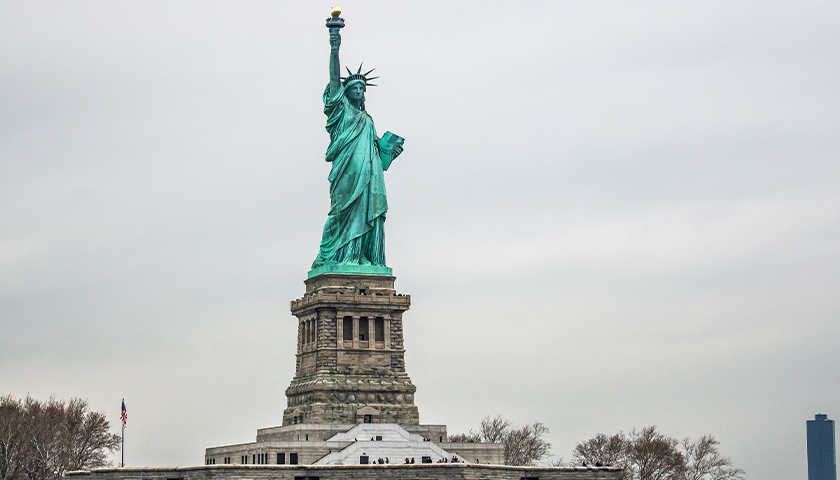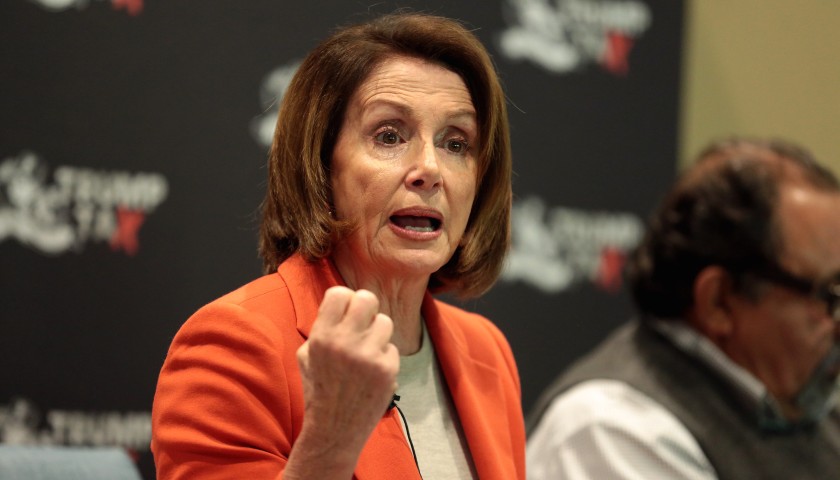U.S. labor markets continued showing signs of weakening as job openings fell to 7.6 million in July, the lowest level since Feb. 2021. Job openings are now 4.6 million below their March 2022 high of 12.2 million, a more than 37 percent drop.
Read MoreTag: employment
Commentary: Foreign-Born Workers are Taking Americans’ Jobs
Something very strange is going on in America’s labor market. The employer’s survey in the June jobs report showed 272,000 jobs gained in May, and nearly 2.8 million jobs over the past year. These are both amazing figures given that the economy is at full employment.
While the employer’s survey is surely fine, the household survey, also produced by the Bureau of Labor Statistics (BLS), tells a strikingly different story, almost as though the country had two different labor markets.
Read MoreCommentary: The Right Needs to Use Public Policies That Promote Family Values
It is a tale as old as time. Older generations criticize the young, usually following a particular formula. The seniors say that the young are wimpier, lazier, less ambitious, overly entitled, and have weaker characters. Examples are now easier to come by because of social media, which allows one to encounter different types of people without having to enter their social circles.
While there are many issues of concern among the young, last week a TikTok rant by a young lady about the difficulty of working and paying her bills went viral. She seemed sad and overwhelmed. Her income apparently could barely cover the rent. Of course, she probably needed a smaller place and a roommate, but her complaints are universal, even among those who are more frugal.
Read MoreFed Continues Rate Pause with Cuts on the Horizon
The Federal Reserve announced on Wednesday that it would not change its benchmark federal funds rate, but does project rate cuts later this year.
Read MoreCommentary: Recession May Be Coming After 514,000 More Americans Struggle to Find Employment
The national unemployment rate reported by the Bureau of Labor Statistics jumped from 3.5 percent to 3.8 percent in August as an additional 514,000 Americans said they could not find work in the Bureau’s household survey. Now 6.3 million Americans are said to be unemployed, the highest in more than a year.
But it did not come with a commensurate drop in the number of Americans saying they were working, which also increased by 222,000 to 161.48 million.
Read MoreJobless Claims Soar to Highest Levels Since 2021
The number of Americans who filed new unemployment claims increased more than expected to 261,000 in the week ending June 3, the Department of Labor (DOL) reported Thursday.
Claims rose 28,000 compared to the previous week’s revised level, the highest number since October 2021, when it was 264,000, according to the DOL. This substantially exceeded the median forecast, which was 236,000, according to MarketWatch.
Read MoreCommentary: The Biden Admin Doesn’t Care About Creating Jobs – They Even Say So
Department of Interior Secretary Deb Haaland said the quiet part out loud last week. As the executive of our public lands agency, she does not believe that Americans need jobs because there are already so many jobs available. It’s better to lock up land, and lock down mining because who wants those jobs, when there are so many others?
Before the U.S. Senate Energy and Natural Resources Committee, Haaland told Sen. Josh Hawley, “Senator, I know that there’s like 1.9 jobs for every American in the country right now. So, I know there’s a lot of jobs,” which was her explanation for canceling cobalt mining permits for Twin Metals Minnesota, an underground mine proposed for the northeastern part of the state. America won’t need those jobs, she was saying.
Read MoreCommentary: Despite ‘Strong’ Rhetoric, Biden Administration Signals Gloomy Economic Outlook
The White House Office of Management and Budget (OMB) in the now-released President’s Budget is projecting just 0.6 percent in inflation-adjusted real growth of the U.S. economy in 2023 as the unemployment rate is expected to rise to 4.3 percent in 2023 and peak at 4.6 percent in 2024 after the economy is finished overheating from the continued, elevated inflation, consumers max out on credit and spending falls off a cliff.
Read MoreBusinesses Fail to Find Workers, and Experts Say Federal Policies Have Made It Worse
A new labor market survey found that a majority of employers, particularly restaurants, still cannot find enough workers.
The new report from Alignable said that 83% of restaurants can’t find enough workers. Overall, the report found that “63% of all small business employers can’t find the help they need, after a year of an ongoing labor shortage.”
Read MoreJob Openings Hardly Budge as Americans Continue to Quit Their Jobs in Droves
Job openings remained nearly unchanged in February while Americans continue to leave their jobs in high numbers, the Bureau of Labor Statistics (BLS) announced Tuesday.
The U.S. saw 11.3 million job openings in February, a slight dip from December’s high of 11.4 million, BLS reported Tuesday. Economists surveyed by The Wall Street Journal estimated job openings would slightly decrease from January’s 11.3 million figure.
Read MoreU.S. Added 678K Jobs in February, While Unemployment Decreased Slightly
The U.S. economy added 678,000 jobs in February, according to a Friday report from the U.S. Bureau of Labor and Statistics (BLS), beating economists’ expectations.
Total nonfarm payroll employment increased by 678,000 in February, according to the BLS report, while the unemployment rate dropped to 3.8%, a pandemic low. Job gains were most pronounced in the leisure and hospitality sectors, which added a total 179,000 jobs.
“The labor market continues to be quite hot,” Nick Bunker, an economist at Indeed, told The Wall Street Journal. “It looks like the labor market is still primed for lots of strong employment growth.”
Read MoreDepartment of Labor Expands Michigan’s Federal Jobless Waivers
The U.S. Department of Labor (USDOL) granted Gov. Gretchen Whitmer’s request to expand the eligibility for waivers for Michiganders who wrongly received Pandemic Unemployment Assistance (PUA) because of the state jobless agency’s mistake.
“Michiganders should not be penalized for doing what was right at the time they applied for federal pandemic benefits,” Whitmer said in a statement. “Coupled with the waivers we applied earlier, we are looking to help Michiganders who needed unemployment benefits to pay their bills, keep food on the table, and continue supporting small businesses. I look forward to working with our legislative partners to continue putting Michiganders first and keeping more money in their pockets.”
The USDOL updated its waiver guidance to approve five new scenarios for consideration of a waiver may apply blanket waivers for recovery of overpayments:
Read MoreTeachers Unions ‘Hold the Education of Kids Hostage,’ Worker Rights Group Says
A worker rights group is calling out two powerful teachers unions, claiming that they “hold the education of kids hostage” in a press release.
Mark Mix, president of the National Right to Work Legal Defense Foundation (NRTWLDF), told the Daily Caller News Foundation that teachers unions like the National Education Association (NEA) and American Federation of Teachers (AFT) are taking advantage of a labor law provision passed in the 1930s for the private sector.
“In several states across the country, union officials, specifically teachers’ union officials, have been granted a really unique privilege called exclusive monopoly bargaining,” Mix said, adding that former President Franklin Delano Roosevelt opposed granting such privileges to public-sector unions while in office.
Read MoreCommentary: Get Ready for a New Roaring Twenties
On New Year’s Eve of 2019, revelers gathered around the globe to ring in a new decade. Many jubilantly attended “Roaring Twenties” parties, adorned in elegant evening wear, cloche and Panama hats, and knickerbockers, harkening back to an exciting, culturally vibrant era of economic prosperity. But whatever veiled hopes partygoers had for a booming future soon met jarring realities: a once-in-a-century pandemic, global lockdowns, an economic recession, and widespread civil unrest stemming from an incident of police brutality. The Roaring 2020s were not to be, it seemed.
Take heart: Mark P. Mills, a physicist, senior fellow at the Manhattan Institute, faculty fellow at Northwestern University, and a partner in Montrose Lane, an energy-tech venture fund, is out to rekindle our collectively dashed hopes. In his new book, The Cloud Revolution: How the Convergence of New Technologies Will Unleash the Next Economic Boom and a Roaring 2020s, Mills convincingly argues with verve, vitality, and – most importantly – evidence, that humanity is about to take a great step forward in the coming decade. And unlike the first Roaring Twenties, these won’t need to end with a Great Depression.
In the opening pages, Mills reminds us that the original Roaring Twenties didn’t start off so auspiciously, either. In fact, separated by a century, our situation seems eerily similar. The 1918 flu pandemic ran well into 1920, triggering a severe U.S. recession that lasted through summer 1921. Violent riots and political instability were also prevalent. Yet from this pit of public despair, Americans pulled themselves out. Propelled by remarkable advancements in mass production, medicine, electrification, communications via telephone and radio, movies, automobiles, and aviation, the United States saw its GDP rise by an astounding 43% between 1921 and 1929.
Read MoreUniversity Fires 100 Professors Due to COVID
As the COVID-19 pandemic continues into its third year, William Paterson University is now laying off 100 full-time faculty over the next three years.
The university, located in Wayne, New Jersey, originally planned to let 150 professors go before union negotiations revised the number to 100, or 29% of the institution’s 340 faculty, reports Inside Higher Ed.
Thirteen tenured professors lost their job at the end of 2021, according to the outlet.
Read MoreFederal Reserve Chairman Powell Says Inflation Poses ‘Severe’ Threat to Job Market
Federal Reserve Chairman Jerome Powell acknowledged Tuesday that high inflation is indeed a serious threat to the U.S. central bank’s goal of helping to get U.S. employees back to work.
He also said the Fed will raise rates higher than initially planned if needed to slow rising prices, according to the Associated Press.
“If we have to raise interest rates more over time, we will,” Powell told the Senate Banking Committee, which is considering his nomination for a second four-year term, the wire service also reports. “High inflation is a severe threat to the achievement of maximum employment.”
Read MoreU.S. Economy Adds Just 199,000 Jobs in December, Far Below Expectations
The U.S. economy recorded an increase of 199,000 jobs in December and the unemployment dipped to 3.9%, the U.S. Bureau of Labor Statistics (BLS) announced Friday.
Total non-farm payroll employment increased by 199,000 in December, according to the BLS, and the number of unemployed Americans dipped to 6.3 million. Economists surveyed by The Wall Street Journal projected the economy to add 422,000 jobs in December and for unemployment to fall to 4.1%.
December’s jobs report leaves the U.S. economy with roughly 6.5 million more jobs than at the end of 2020 but still 3.5 million short of pre-pandemic levels.
Read MoreNovember Jobs Report Is One of the Worst Since Biden Took Office
The U.S. economy added 210,000 jobs in November, marking nearly the lowest number of jobs created in a month since President Joe Biden took office in January.
November’s jobs report was well below economists’ estimate of 573,000, according to CNBC. Additionally, unemployment fell to 4.2% from October’s 4.6% figure, according to the Bureau of Labor Statistics (BLS).
The U.S. economy, still recovering from the COVID-19 pandemic but now subject to uncertainty related to the Omicron coronavirus variant, appeared to slow in momentum in November, The Wall Street Journal reported.
Read MoreLabor Board Orders New Union Election at Amazon Warehouse
The National Labor Relations Board (NLRB) ordered a new unionization election at an Amazon warehouse in Alabama, ruling that the company violated federal labor law during the first election.
“Today’s decision confirms what we were saying all along – that Amazon’s intimidation and interference prevented workers from having a fair say in whether they wanted a union in their workplace – and as the Regional Director has indicated, that is both unacceptable and illegal,” Retail, Wholesale and Department Store Union (RWDSU) President Stuart Appelbaum said in a statement Monday.
“Amazon workers deserve to have a voice at work, which can only come from a union,” he continued.
Read More20 Months into Pandemic, over 20,000 Michigan State Workers Remote
Twenty months after the COVID-19 pandemic struck Michigan, downtown Lansing hasn’t recovered fully. Half of the state’s roughly 48,000 employees are still working remotely.
The disappearance of daily consumption habits of more than 22,000 state workers have hurt local businesses, whether that’s grabbing a bagel from The New Daily Bagel, rolls from AnQi Sushi Express or a shake from Soul Nutrition. Some businesses have adjusted accordingly, cutting hours, closing locations, and reducing menus.
The Michigan Department of Technology, Management, and Budget (DTMB) Spokesman Caleb Buhs said about half of state workers are working remotely on a daily basis.
Read MoreCommentary: I am Challenging the Vaccine Mandate to Protect My Workers’ Jobs
The Biden administration has finally published its anticipated ultimatum threatening companies like mine with severe fines and penalties for not firing any employee who declines to be vaccinated against or submit to invasive weekly testing for COVID-19. The new rule promulgated by the U.S. Labor Department’s Occupational Safety and Health Administration (OSHA) under the guise of workplace safety may well bankrupt the business my father founded. So, as the CEO of the Phillips Manufacturing & Tower Company, I am joining with The Buckeye Institute to challenge OSHA’s vaccine mandate in court. Here’s why.
Phillips is a 54-year-old company based in Shelby, Ohio, that manufactures specialty welded steel tubing for automotive, appliance, and construction industries. OSHA’s emergency rule applies to companies with 100 or more employees — at our Shelby Welded Tube facility, we employ 104 people. As a family-owned business I take the health of my workers seriously — they are my neighbors and my friends. When I heard of the mandate, we conducted a survey of our workers to see what the impacts would be. It revealed that 28 Phillips employees are fully vaccinated, while antibody testing conducted at company expense found that another 16 employees have tested positive for COVID-19 antibodies and likely possess natural immunity. At least 47 employees have indicated that they have not and will not be vaccinated. Seventeen of those 47 unvaccinated workers said that they would quit or be fired before complying with the vaccine or testing mandate. Those are 17 skilled workers that Phillips cannot afford to lose.
Perhaps the Biden administration remains unaware of the labor shortage currently plaguing the U.S. labor market generally and industrial manufacturing especially. Like many companies, Phillips is already understaffed, with seven job openings we have been unable to fill. Employees already work overtime to keep pace with customer demand, working 10-hour shifts, six days a week on average. Firing 17 veteran members of the Phillips team certainly won’t help.
Read MoreAmerican Airlines Cancels More Flights Citing Weather and Labor Shortage
American Airlines canceled 340 flights on Monday after cutting almost 2,000 flights during the weekend due to staffing shortages and weather delays, multiple sources reported.
The airline cut 343 flights Friday, 548 Saturday, and over 1,000 Sunday, according to American Airlines data obtained by the Daily Caller News Foundation.
The company canceled 2,291 flights as of Monday morning, representing over 10% of its schedule.
Read MoreBig Tech Companies Are Defying Texas’ Vaccine Mandate Ban
Major tech companies are continuing to require their employees to be vaccinated at their Texas facilities, in violation of Gov. Greg Abbott’s executive order banning all vaccine mandates.
Abbott signed an executive order on Oct. 11 prohibiting “any entity,” including private businesses, government contractors and local schools, from imposing a requirement that employees be vaccinated as a condition of employment. However, Google, Facebook, HPE, Twitter and Lyft have yet to lift their vaccine mandates in response to the order, Protocol first reported.
HPE spokesman Adam Bauer confirmed the company had not changed its vaccine policy, and told the Daily Caller News Foundation that the company was making “vaccination a condition of employment for U.S. team members to comply with President Biden’s executive order and remain in good standing as a federal contractor.”
Read MoreRoughly 40 Percent of Americans Say They Recently Suffered Financial Difficulties, Study Shows
Over 40% of U.S. households said they experienced severe financial hardship during the COVID-19 pandemic, citing difficulties paying bills, credit cards and draining their savings, according to a Harvard University report.
The survey conducted by the Harvard T.H.Chan School of Health, the Robert Wood Johnson Foundation, and the National Public Radio asked roughly 3,600 participants between July and August about problems they faced during the pandemic and how it affected their lives in recent months. Respondents were asked about financial, healthcare, education and personal safety concerns.
Roughly 30% of adults interviewed said they used up all or most of their savings during the pandemic, while 10% reported they had no savings before the pandemic began, according to the report. About one in five households had difficulties paying credit cards, loans, and other debts as well as utilities.
Read MoreU.S. Economy Added 194,000 Jobs in September, Badly Missing Expectations
The U.S. economy reported an increase of 194,000 jobs in September, and the unemployment rate fell to 4.8%, according to Department of Labor statistics.
The number of unemployed people fell by 710,000 to 7.7 million, according to the Department of Labor statistics released Friday. Economists projected that employers created 500,000f jobs in September, more than double the figure in August, according to the Wall Street Journal.
Despite the spike in employment, the labor market remains thin due to the pandemic, and job growth earlier in the year was considerably stronger, according to the WSJ.
Read MoreUniversity of Michigan-Flint Grant to Support 300 Jobs, $10.4M Investment in Flint
The U.S. Secretary of Commerce’s Economic Development Administration (EDA) awarded a $3.8 million Coronavirus Aid, Relief, and Economic Security Act (CARES) Recovery Assistance grant to the University of Michigan-Flint, Flint, to construct the university’s new College of Innovation and Technology.
The grant, to be matched with $4.9 million in local funds, is expected to create 126 jobs, retain 175 jobs, and generate $10.4 million in private investment.
“We are grateful to Secretary Raimondo and the Biden Administration for investing in University of Michigan-Flint’s College of Innovation and Technology,” Whitmer said in a statement. “This grant will help us usher in a new era of prosperity by supporting over 300 good-paying jobs and generating $10.4 million in private investment.”
Mayor Sheldon Neeley welcomed the investment.
Read MoreU.S. Economy Added Just 235,000 Jobs in August, Way Short of Economists’ Projections
The U.S. economy added 235,000 jobs in August and the unemployment rate fell to 5.2%, according to Department of Labor data released Friday.
The number of unemployed people decreased to 8.4 million, according to the Bureau of Labor Statistics report. Economists projected 720,000 Americans — roughly three times the actual number — would be added to payrolls prior to Friday’s report, The Wall Street Journal reported.
“Despite the delta variant, there is still an opening up of the service sector of the U.S. economy,” Nationwide Mutual Insurance Chief Economist David Berson told the WSJ. “While that started some months ago, it’s not nearly complete.”
Read MoreU.S. Economy Added Whopping 943,000 Jobs in July as Recovery Accelerates
The U.S. economy reported an increase of 943,000 jobs in July and the unemployment rate fell to 5.4%, according to Department of Labor data released Friday.
Total non-farm payroll employment increased by 850,000 in July, according to the Bureau of Labor Statistics report, and the number of unemployed persons decreased to 8.7 million. Economists projected 845,000 Americans would be added to payrolls prior to Friday’s report, The Wall Street Journal reported.
“The jobs recovery is continuing, but it’s different in character to any we’ve seen before,” payroll software firm ADP economist Nela Richardson told the WSJ. “I had been looking at September as a point when we could gain momentum—with schools back in session and vaccines widely available. But with the delta variant, we need to rethink that.”
Read MoreLabor Shortage Slows Oil Production in Major Fracking State
A shortage of workers has contributed to a significant crude oil production slowdown in North Dakota, the second-largest U.S. oil hub behind only Texas.
The labor shortage has caused oil output to become “flat as a pancake,” North Dakota State Mineral Resources Director Lynn Helms told The Bismarck Tribune. Energy companies have struggled to find workers needed to do the laborious work — injecting water, sand and chemicals into wells to extract oil — associated with fracking.
“Most of these folks went to Texas where activity was still significantly higher than it was here, where they didn’t have winter and where there were jobs in their industry,” Helms said, according to the Tribune. “It’s going to take higher pay and housing incentives and that sort of thing to get them here.”
Read MoreMichigan Jobs 322,000 Under Pre-Pandemic Level
Sixteen months after the COVID-19 pandemic began, Michigan is still behind 322,000 jobs compared to pre-pandemic in Feb. 2020.
Michigan’s seasonally adjusted jobless rate of 5% percent was unchanged in June, according to data released by the Michigan Department of Technology, Management & Budget.
“Michigan’s labor market indicators were little changed in June,” Wayne Rourke, the associate director of the Bureau of Labor Market Information and Strategic Initiatives, said in a statement. “The Michigan unemployment rate has been near 5.0 percent for five consecutive months. Payroll job counts in June were similar to March levels.”
Read MoreGov. Whitmer Secures $10 Million Grant to Expand Employment Opportunities
Gov. Gretchen Whitmer announced the Michigan Department of Labor and Economic Opportunity (LEO) has been awarded a $10 million federal grant to support the state’s registered apprenticeship expansion efforts.
“As we put Michigan back to work, Registered Apprenticeship programs offer on-ramps to high-demand, high-skill careers, and in Michigan we have committed to expanding these educational opportunities to ensure more Michiganders can get good-paying jobs,” Whitmer said in a statement.
“Increasing access to education and training opportunities will help us achieve our 60 by 30 goal to have 60% of Michigan’s adult with post-secondary education or skills training by 2030, improve the quality of life and help Michiganders secure good-paying jobs, and ensure businesses have the workforce they need to succeed and grow our economy.”
Read MoreEconomy Added 850,000 Jobs in June, Well Above Economists’ Forecasts
The U.S. economy reported an increase of 850,000 jobs in June and the unemployment rate ticked up to 5.9%, according to Department of Labor data released Friday.
Total non-farm payroll employment increased by 850,000 in June, according to the Bureau of Labor Statistics report, and the number of unemployed persons increased to 9.5 million. Economists projected 700,000 Americans would be added to payrolls prior to Friday’s report, according to The Wall Street Journal.
“This is a trickier phase of the recovery,” Wells Fargo senior economist Sarah House told The New York Times.
Read MoreCommentary: Minimum Wage Hikes Led to Lower Worker Compensation, New Research Shows
Opponents of minimum wage laws tend to focus their criticism on one particular adverse consequence: by artificially raising the price of labor, they reduce employment, particularly for the most vulnerable in society.
“Minimum wage laws tragically generate unemployment, especially so among the poorest and least skilled or educated workers,” economist Murray Rothbard wrote in 1978. “Because a minimum wage, of course, does not guarantee any worker’s employment; it only prohibits, by force of law, anyone from being hired at the wage which would pay his employer to hire him.
Though some economists, such as Paul Krugman, reject Rothbard’s claim, a recent study found the overwhelming body of academic research supports the idea that minimum wage laws increase unemployment.
Read More‘Operation Warp Speed for Jobs’: Worker Shortage Is Getting Worse, U.S. Chamber Says
The U.S. Chamber of Commerce characterized the worker shortage as a crisis that is hurting businesses of all sizes and slowing the nation’s economic recovery.
The biggest challenge U.S. businesses currently face is the lack of qualified workers to fill open jobs, according to the Chamber of Commerce’s America Works Report released Tuesday morning. The national Worker Availability Ratio (WAR) — or ratio of number of available workers to number of available jobs — has dropped over the last several months, the report found.
The current WAR is 1.4, meaning for every job opening there are one or two workers available, according to the America Works Report. The historical WAR average over the last 20 years is 2.8.
Read MoreAnalysis: Jobs, Housing Show Recovery Continues
There were only two insightful reports on the economy this past week—for jobs and housing. Both show impressive gains.
Weekly initial unemployment claims fell by 56,000, to 787,000. They are down more than 100,000 from a month ago. There has also been a substantial decline in the insured unemployment rate to 5.7 percent from 8.7 percent a month ago. Also, the number of people receiving unemployment insurance payments fell to 8.4 million; it was 12.6 million a month ago.
Read MoreCommentary: 4.4 Million Lose Unemployment Benefits Since August as Pelosi Puts Politics Above People
Small business relief, supporting 5.2 million small businesses and 50 million jobs, ran out on Aug. 8 and airlines ran out of money last month as massive layoffs have been ensuing.
In the meantime, House Speaker Nancy Pelosi (D-Calif.) continues to refuse a deal from President Donald Trump to extend these CARES Act programs — even if it means she loses a few seats in the House over it.
Read MoreCVS to Hire 15,000 Employees in Preparation for Flu Season, COVID-19 Vaccine Rollout
CVS Health announced that it would bring on approximately 15,000 additional workers in preparation for the upcoming flu season and an expected rise in coronavirus cases before the distribution of an eventual vaccine.
The hirings will take place before the year’s end, the company said Monday in a statement. Though most of the positions are temporary, many could transition into full-time positions, CVS said.
Read More661,000 Jobs Added in September, Less Than Expected
The U.S. economy added 661,000 jobs in September, while unemployment fell to 7.9%, according to Department of Labor data released Friday.
Total non-farm payroll employment rose by 661,000 in September, according to the Bureau of Labor Statistics report, and the number of unemployed persons fell by 1 million to 12.6 million.
Read More




































